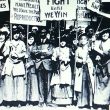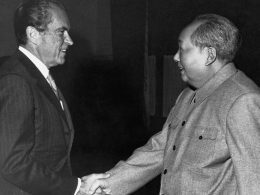By James McCabe
We live in a world that is saturated with violence. The lives of millions of people today are scarred by war, ethnic cleansing and even genocide. As capitalism is an economic system based on competition and exploitation, it has individualism, narcissism, coercion and abuse stitched into its very fabric.
This system damages and brutalises people of all genders who then often behave in toxic and abusive ways. However, there is a very particular relationship between violence and masculinity in capitalist society.
Cis men are overwhelmingly the perpetrators of physical violence across the world, but this aspect of gendered violence is rarely commented upon. Statistics are published about “how many women are assaulted each year”, rather than “how many men assault women each year”. The 25th of November is the International Day for the Elimination of Violence Against Women, but the problem with the term “violence against women” is that it removes the active agent from the sentence. Therefore, many anti-violence campaigners instead use the term “men’s violence against women” to bring the most common group of perpetrators into the spotlight. This term shifts the focus to how the socialisation of men is connected to the prevalence of violence in capitalist society.
The “boys will be boys” effect
The normalisation of sexual violence goes hand in hand with the normalisation of men’s violence. Dangerous and anti-social masculine behavioural norms are explained away as being normal and natural. In everyday language, the concept of “boys will be boys” legitimates problematic behaviours and there is no equivalent term of “girls will be girls”. Even if one rejects the legitimacy of the concept of “boys will be boys”, it holds a particular meaning, whereas “girls will be girls” doesn’t have a particular meaning or connotation.
Because sexual violence is so broadly normalised, most men who commit rape don’t consider themselves to be rapists. When abuse is discussed in the abstract, the media tends to frame abusers as either monsters or weirdos and their actions are removed from any social context. In reality, many abusers and rapists are very “normal” fathers, teachers, doctors, sports coaches, community leaders and so on. But often, when specific examples of gender violence and femicide are discussed, the perpetrators are then humanised; particularly if they are white or “respectable” middle-class or upper-class men. A vivid and grim example of this took place in County Clare in November 2023 when a woman was murdered by her husband of 30 years who then took his own life. The priest who presided over the joint funeral of the femicide victim and perpetrator ignored the cause of their deaths but spoke about the perpetrator’s “barbeque skills”, his “love of cycling” and the “many great friends he had at Dolmen cycling club.”
When white American men perpetrate acts of terror such as mass shootings: the media and wider establishment often humanise these perpetrators, focusing on their mental health or their use of violent video games as causes for their acts of extreme violence. But the gendered aspect of the violence is rarely commented upon. By contrast, whenever a nonbinary or trans person has carried out a mass shooting, their gender identity becomes the main focus of the media, as the supposed cause of their violent behaviour. Reality is turned on its head in this example. The Gun Violence Archive recorded over 4,400 mass shootings during the 2010s, with known transgender suspects in fewer than 10 cases, translating to around 0.11% of all mass shootings. Additionally, The Violence Project, a research group that tracks US mass-shooting data dating back to 1966 found that a staggering 98% of these crimes were committed by cis men. (It’s also worth noting the Gun Violence Archive’s findings that in 68.2% of the mass shootings between 2014 and 2019, the perpetrators either killed family or intimate partners or the shooter had a history of domestic violence.)
The “whataboutery” phenomenon
In California in 2014 a horrific mass shooting was carried out by a man who had written a warped, misogynistic statement detailing his motivation. Millions of Tweets by women using the Twitter hashtag #yesallwomen were posted in response to this case of misogynist terrorism. The “yes all women” slogan was framed in response to the widespread “not all men” phrase that people are often met with online when making feminist arguments. This “yes all women” slogan amplified the notion that all women face sexual harassment in their lifetime, and was later echoed by the “97 percent” trend on TikTok in 2021, which referred to a study where 97% of women respondents divulged that they had been victims of sexual assault.
Some people may argue against the emphasis on “men’s violence” on the basis that some men are victims of intimate partner violence at the hands of women. Of course, many women act in physically and mentally abusive ways, but men’s violence goes in tandem with masculine gender norms whereas women’s violence goes against stereotypically feminine gender norms.
Male supremacists like to point out how men have shorter life expectancy rates and higher suicide rates than women, as though this is ignored by feminism. But in reality, feminists were the first to uncover how men also suffer from the gendered nature of their existence. The men’s health movement was an outgrowth of the feminist movement, and feminists have been to the fore in highlighting that one in five men have been victims of sexual abuse as children. Men also constitute the overwhelming majority of murder victims and casualties of war. It should come as no surprise then, that cis men have a strong self-interest in joining the socialist feminist struggle to end men’s violence.
Biological essentialism: a distinctly ignorant defence of the status quo
A growing chorus of anti-feminist influencers have aligned around biological essentialism – the idea that a person’s nature or personality is innate; arising from, or connected to, their biological traits. As part of a more general rightwing backlash in recent years, the political establishment and media have increasingly pushed transphobic narratives. For example, one chief executive of a UK gender violence charity argued publicly that trans women should not have access to women’s refuge shelters. She stated, “you are not offering a trauma-informed environment if you, in your position of power, gaslight traumatised women and pretend that someone that you both really know is a man is actually a woman.”1 Feminist and trans woman Shon Faye has dismantled this sort of bigotry, “The idea that anyone born with a penis is inherently more aggressive or violent because they have a penis is an anti-feminist idea: it actually suggests that men’s violence is linked to biological ‘essence’ and is therefore inevitable, immutable, perhaps not even truly men’s fault.”2
Male supremacists like Andrew Tate and Jordan Peterson double down in defence of hypermasculine norms in the belief that masculinity is innate rather than a product of how men are socially conditioned under capitalism. In contrast to these ignorant and deeply pessimistic beliefs, Marxists see behaviours and gender norms as socially constructed rather than biologically determined.
There’s nothing “natural” about rigid gender norms
Amongst the wider population, people often associate the term “gender” specifically with women. The term “gender studies” is often assumed to be interchangeable with “women’s studies”, for example. To avoid confusion on this, we will investigate the concept of the gender binary. The gender binary describes how certain behaviours and character traits in society are categorised as distinctly feminine or distinctly masculine. Behaviours and traits are gendered, and masculinity and femininity are considered opposites. Gender identities are thus imposed on us at birth, based on our anatomy and genitalia. Growing numbers of intersex, trans and non-binary people reject their assigned genders, but most people interpret their assigned gender at birth as an essential part of their identity and continue to identify with that gender for the rest of their lives.
Female and male infants are dressed in pink or blue clothes to cultivate distinctly gendered identities before they can even talk. If you look through any toy shop you will notice that young girls are encouraged to play with toy babies, Barbies, and cosmetics while boys are given action figures, toy tanks and guns. Girls are told “girls don’t fight”, while boys are told to “man up” and that “boys don’t cry”, and so on.
The gender binary is thus reproduced in each generation through social cultivation by parents and relatives, the media, the education system, and the state. Of course, in the real world, you have a wide spectrum where cis women display many masculine character traits and cis men display many feminine traits. On the whole, though, being submissive, caring, devoted, humble, and emotionally expressive are stereotypically feminine traits while being seen as assertive, aggressive, and emotionally stoic, are designated as masculine traits.
Man-box culture
In the fields of gender studies and masculinity studies, the concept of man box culture refers to the rigid set of expectations, behaviours and perceptions that are considered “manly”, and imposed on cis hetero men by capitalist society. Behaviours and beliefs of man-box culture include a sense of superiority towards women, emotional suppression, a sense of sexual and interpersonal entitlement, an unwillingness to admit weakness, lack of emotional or physical intimacy with other men, being overly competitive, dehumanisation and objectification of women, and a degree of queerphobia. In addition to this, many middle-class or educated men incessantly compete intellectually with others, trying to prove their superior level of knowledge, etc.
In man-box culture, behaviours such as emotional expression, empathy and caregiving are gendered as feminine, and if boys – or even men – step outside of the man box they get sanctioned through verbal taunting or physical threats. While openly gay cis masculinity has become a more accepted part of mainstream bourgeois culture in some parts of the world, masculine norms have long been strongly associated with heteronormativity, and consequently, man-box culture operates to police heteronormativity in capitalist society.
Men’s violence should be viewed as an outgrowth of socially constructed masculine norms, with a continuum that contains mansplaining, manspreading and macho banter on one end of the spectrum, and mass shootings and femicide on the other. The global feminist wave of the 2010s brought the term “toxic masculinity” into the mainstream, as struggles against gender oppression created a more widespread critical consciousness towards hyper-masculine and masculine gender norms. Hyper-masculinity refers to the problems caused by accentuated masculine behaviour, whereas “toxic masculinity” can give the illusion that rigid gender norms can be healthy and positive but are sometimes problematic. A further drawback with the term “toxic masculinity” is that it leans into the simplistic “good vs bad man” binary.
It’s worth noting that cis masculine identity in capitalist society is inseparable from the oppression of women and queer people. Of course, men can consciously reject hyper-masculine norms to try to be a “good person”; treating the people in their lives with respect, etc, but there’s no reason why Marxists should celebrate femininity or masculinity in and of themselves, as the gender binary inherently stifles individual development. Our lives are only shells of what they could be without these constricting gender norms. But the gender binary is not an incidental aspect of the capitalist mode of production, it is fundamental to it. Ultimately, ending the conditions that fortify the gender binary means ending capitalism.
Capitalism needs the gender binary
The central contradiction of capitalism is that capital is generated through the exploitation of working-class labour. This central contradiction creates an unavoidable class conflict that can only be fully resolved either through the development of class consciousness, workers’ power and socialist change, or through intensified exploitation, crisis, war, mass impoverishment and ruin. But the development of capitalism can’t be understood by explaining this aspect alone. When dealing with real social processes, we need to explain how this central contradiction of capitalism is expressed, often in very different forms in all the economic, political, cultural, legal and ideological aspects of society.
Capitalist ideology is used to divide working-class people in all sorts of ways, including by promoting racist, sexist, queerphobic and ableist ideas. As with racial oppression, the character of how gender oppression manifests and is reproduced has changed over time and from place to place, but as a totality, the capitalist system has never existed without gender oppression and can’t exist without it. Gender oppression is an inextricable feature of capitalism, not only because workers are divided along gender lines, but because capitalism relies on the unpaid labour that women provide in rearing children and caring for sick and elderly people. Women’s unpaid and virtually unlimited labour is vital for the functioning of capitalism as it ensures the reproduction of the next generation of wage workers to generate profits. Beyond the family, rigid gender roles are necessitated by many services and industries that allow capitalism to function. Nursing, care work, childcare, hospitality, and so forth are generally feminised and low-paid. As a result, feminine and hyper-feminine gender norms have a real material purpose for capitalism.
Similarly, the materialist roots for rigid masculine norms lie in capitalism’s dependence on organised violence and men’s role in the oppression of women. The hyper-masculinity celebrated in Hollywood, sports culture, rock, hip-hop, video games and literature is an outgrowth of the militarism and gendered violence inherent to capitalism. Countless folk tales and stories worldwide are centred around the “man as hero” trope, while the dominant narratives in the Western world centre the experiences of the white, formally-educated man as the supposedly neutral, universal human experience.
The socialist approach to men’s violence
Because the working class is the only force that can end capitalism, socialists have always correctly emphasised what unites workers rather than what divides them. But in doing so some socialists have crudely argued that interpersonal and state violence are ultimately products of capitalism, and therefore the connection between men and violence should be downplayed. This usually comes from a concern that drawing attention to the relationship between masculinity, violence and capitalism could be misinterpreted as socialists saying that all men are inherently violent. But in fact, the opposite is true and ignoring the connection between masculinity, violence and capitalism inadvertently legitimises the false mainstream narrative that men are naturally and innately violent.
It’s not enough to win men to be empathetic to women’s suffering or sympathetic to women’s struggles. Suppose men develop an understanding of how they have been socialised in a particular way for the benefit of capitalism’s oppression of women. In that case, it can lead them to a more profound outlook towards the struggle against capitalism and the gender binary it relies upon.
Socialists need to recognise that the ruling class fosters material and cultural advantages for cis, masc-presenting and heteronormative workers as part of the oppression of women and queer people. It’s no accident that married men live longer than unmarried men, while unmarried women live longer than their married counterparts. However, although working-class men have advantages over working-class women – such as having more free time and fewer care responsibilities within families – because they are workers, their fundamental material interests align with the struggle for socialist change.
Everything to gain from socialist feminism
Although there are very few examples of Marxists analysing masculinity specifically, well-known revolutionaries have grappled with the question of the role of men in fighting oppression. In a letter to Clara Zetkin, Lenin argued that specific educational work must be done among men in the Communist Party on the question of gender oppression:
“They regard agitation and propaganda among women and the task of rousing and revolutionising them as of secondary importance, as the job of just women Communists… Unfortunately, we may still say of many of our comrades, ‘Scratch the Communist and a philistine appears’… Our communist work among the masses of women, and our political work in general, involves considerable educational work among the men. We must root out the old slave-owners point of view, both in the Party and among the masses”.3
Similarly, Leon Trotsky acknowledged the counter-productive role that masculinity can play in the workers’ movement when he stated that “there are no limits to masculine egotism in ordinary life”.4 However, some quarters of the Trotskyist movement subsequently abandoned a critical analysis of the gender binary; adapting to the norms and behaviours dictated by the status quo. For example, Ted Grant – a founding member of the Committee for a Workers’ International and later the International Marxist Tendency – claimed in the 1970s that ‘homosexuality’ was a capitalist “deviation” that would “disappear” under socialism. Grant’s views on this issue were not only bigoted but anti-materialist as they missed how capitalism needs the gender binary. Thankfully, this anti-materialist ignorance has largely been dispelled by queer revolutionaries in the Trotskyist movement who have shown how the gender binary is a deviation of class-based societies that would disappear under socialism.
Traditionalist backlash
Polling data today seems to indicate a growing anti-feminist sentiment amongst Gen Z and Millennial men. Clearly, the organised backlash against feminism and #MeToo by right populism is gaining widespread traction. Fortunately, there is also a growing layer of men who have been positively impacted by #MeToo and feminism and are reflecting critically on their past behaviour and conditioning. Socialist feminist men can draw on their lived experience to combat the cringeworthy nonsense arguments of male supremacists amongst their male peers. And they can go a step further by fighting alongside women and queer people against capitalism.
The family and the state are key institutions for capitalism, and both play a particular role in shaping gender norms. But in the broad sweep of history, the nuclear family and the state are quite recent developments. Defenders of the modern family argue that rigid gender norms and men’s domination over women and children are both natural and eternal. The cliché of the man out hunting to bring food back to his partner who is the sole carer of their children is the result of people taking the (idealised) modern nuclear family and imposing it onto our early ancestors.
Women hunters, male carers
Archaeological evidence often contradicts gender stereotypes. For example, the remains of a 9,000-year-old female skeleton found in Peru indicated that she was a hunter of big game. Further excavations of the area where she was buried pointed to the significant involvement of women in big-game hunting.
For 99% of human evolution, people lived in hunter-gatherer, foraging societies.
Of all the world’s people today, immediate-return foragers live a lifestyle that most closely resembles the way the earliest humans lived. They are the most egalitarian type of hunter-gatherers. These people aren’t egalitarian because of some inherent moral purity, but because they need social cohesion to survive in groups of 50 to 100 people. Any displays of interpersonal aggression and violence are severely frowned upon in these societies. Sanctions are employed against bullies, braggers or those deemed stingy, as sharing and cooperative dependence are essential survival skills for the entire group.
Contrary to the bio-essentialist stereotypes, fathers also play a much greater role in childcare in foraging societies than they do within the nuclear family unit under capitalism. Fathers amongst the Aka people who live in the Congo Rainforest remain within their babies’ eyesight 88% of the time. They are within arm’s reach 50% of the time and hold babies 22% of the time. The Aka people hunt with nets and often a mother will go into the forest to hunt with a group of relatives while fathers stay at home to look after their offspring.5
The roots of gender oppression
The foraging lifestyle that our early ancestors practised to survive required gender equality. Since this was a hand-to-mouth existence, there was no surplus wealth to cream off, which would allow some people to live a non-labouring life. So everyone was working. Before the development of agriculture, there was no class division, there was no state, no property, money, and no rulers. With regard to the relationship between masculinity and violence, it’s worth emphasising that there is no evidence of intergroup warfare in human populations before the development of agriculture.
The onset of farming thousands of years ago, saw populations grow. Farming societies with large surpluses of food and wealth became more complex, hierarchical and stratified. Some men began to monopolise more of the surplus wealth through the coercion of other people’s labour and surplus produce. Class divisions, the private ownership of wealth and the exploitation of labour developed alongside the rise of the state. The need for police and armies to protect the wealth of rulers and enforce labour exploitation meant that a (violent) macho culture developed to maintain the status quo.
Monogamous marriage and the sexual double standard
These first states also saw the development of the patriarchal family unit and monogamous marriage, as ruling-class men and better-off farmers wanted to pass their property down to their sons. To ensure the paternity of their children, a culture developed curtailing the freedom of association and freedom of movement of women. The idea was that in the absence of strict monogamy, a property-holding man could not be certain that his wife’s children were also his own and that his wealth would be passed on to his biological children. This led to a sexual double standard that required monogamy for women only. In classical patriarchal families of Greece or Rome, women were legally restricted to monogamy while men were allowed to practise polygyny.6 In Ancient Babylon the Code of Hammurabi made female infidelity punishable by death.7
The hallmarks of polygyny and early forms of monogamous marriage are still visible in Western culture today. Despite polygyny being legally abolished in most societies long ago, men continue to enjoy greater sexual freedom than women. If men are sexually promiscuous they are graciously labelled with epithets such as ladies’ man, heartbreaker or player, while women generally lose social status by being promiscuous. And these cultural norms sometimes lead to men feeling a sense of entitlement to control their partner. This double standard normalises male sexual jealousy and the slut-shaming and victim-blaming of women.
The dynamics of the nuclear family mean that men can leave the family and won’t face the same social pressure to be fully responsible for their children, whereas women can never “abandon” their children without facing major social stigma and potential ostracisation. That reality alone creates a power imbalance that favours men and enables abusive relationships to develop.
A socialist society striving to end the oppressive ideas and norms of capitalist society would necessitate ending the gendered nature of childcare. Free well-resourced, quality public childcare, housing, cafés and restaurants are important aspects of a programme for socialist change to free women from the socially-coerced unpaid labour that they are forced to perform in capitalist society. Only a working-class struggle from below can achieve the revolutionary change necessary to improve the quality of life for all and end the violence of capitalist state rule and the coercion inherent in the family.
The gendered nature of state violence today
To safeguard their private property, the ruling class needs a state apparatus of armed forces such as the police and military. These institutions have developed in tandem with hyper-masculine gender norms. The capitalist class maintains its rule primarily through ideological means, but its repressive apparatus is essential. The military is built on a foundation of moulding mainly young men into trained killers. So armies and hyper-masculinity are tied together like copy and paste. The protection of capitalist class rule through the state has been maintained in part by macho culture. Research consistently shows that male soldiers perpetrate intimate partner violence at three times the levels of the general population. There is also consistent evidence that family violence is four times higher among police officers than in the general male population.
Hyper-masculinity is also central to illegal industries such as the drug trade, where dealers and suppliers enact violence against their competitors to gain a bigger slice of the market. Wherever there has been a rise in drug trade-related violence there has been a corresponding increase in gender violence, as seen in Honduras, El Salvador, Mexico and Brazil.
It’s also worth stating that every counter-revolutionary or fascist force in history has been drenched in hyper-masculinity.
In the struggle for real workers’ unity, revolutionaries can’t ignore the sophisticated ways that capitalist institutions and ideology divide the working class. A stronger grasp of these divisions will clear the path to greater solidarity and mutual respect. There are countless reasons why working-class cis men should fight alongside women and queerfolk against capitalism. Working-class men have a strong interest in organising against both the capitalist exploitation they face and the rigid gender roles and hyper-masculinity that are so destructive to themselves and those around them. They have everything to gain.
Notes:
- Shon Faye The Trans Gender Issue: An Argument for Justice (2021), page 57
- Ibid, page 241
- Lise Vogel Marxism and the Oppression of Women (2014), page 127
- Trotsky “Against bureaucracy, progressive and unprogressive” in Problems of Everyday Life (1973), 65
- Sarah Blaffer Hrdy Mothers and Others (2011), pages 128 & 163
- Sharon Smith Women and Socialism: Class, Race, and Capital (2015), page 33
- Stephanie Coontz and Peta Henderson Women’s Work, Men’s Property: The Origins of Gender & Class (1986), page 153












